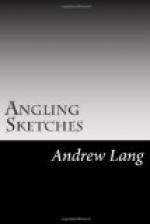The site of this ruined cottage, however, had no terrors for the neighbours, or rather for the neighbour, my shepherd. In fact, he seemed to have forgotten the legend till I reminded him of it, for I had come across the tale in my researches into the Unexplained. The shepherd and his family, indeed, were quite devoid of superstition, and in this respect very unlike the northern Highlanders. However, the fallen cottage had nothing to do with my own little adventure in Glen Aline, and I mention it merely as the most notable of the tiny ruins which attest the presence, in the past, of a larger population. One cannot marvel that the people “flitted” from the moors and morasses of Glen Aline into less melancholy neighbourhoods. The very sheep seemed scarcer here than elsewhere; grouse-disease had devastated the moors, sportsmen consequently did not visit them; and only a few barren pairs, with crow-picked skeletons of dead birds in the heather now and then, showed that the shootings had once perhaps been marketable. My shepherd’s cottage was four miles from the little-travelled road to Dalmellington; long bad miles they were, across bog and heather. Consequently I seldom saw any face of man, except in or about the cottage. My work went on rapidly enough in such an undisturbed life. Empires might fall, parties might break like bursting shells, and banks might break also: I plodded on with my labour, and went a-fishing when the day promised well. There was a hill loch (Loch Nan) about five miles away, which I favoured a good deal. The trout were large and fair of flesh, and in proper weather they rose pretty freely, and could be taken by an angler wading from the shore. There was no boat. The wading, however, was difficult and dangerous, owing to the boggy nature of the bottom, which quaked like a quicksand in some places. The black water, never stirred by duck or moorhen, the dry rustling reeds, the noisome smell of decaying vegetable-matter when you stirred it up in wading, the occasional presence of a dead sheep by the sullen margin of the tarn, were all opposed to cheerfulness. Still, the fish were there, and the “lane,” which sulkily glided from the loch towards the distant river, contained some monsters, which took worm after a flood. One misty morning, as I had just topped the low ridge from which the loch became visible, I saw a man fishing from my favourite bench. Never had I noticed a human being there before, and I was not well pleased to think that some emissary of Mr. Watson Lyall was making experiments in Loch Nan, and would describe it in “The Sportsman’s Guide.” The mist blew white and thick for a minute or two over the loch-side, as it often does at Loch Skene; so white and thick and sudden that the bewildered angler there is apt to lose his way, and fall over the precipice of the Grey Mare’s Tail. When the curtain of cloud rose again, the loch was lonely: the angler had disappeared. I went on rejoicing, and made a pretty good basket,




